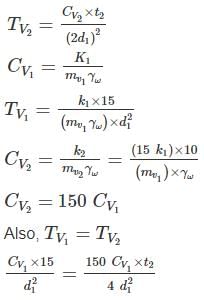Test: Soil Mechanics- 5 - Civil Engineering (CE) MCQ
10 Questions MCQ Test - Test: Soil Mechanics- 5
Which of the following is NOT an assumption in Terzaghi’s one-dimensional consolidation theory?
Match List – I (Equipment) with List-II (Purpose) and select the correct answer using the codes given below the lists:


Choose the correct statement
1. Soils with small volume changes are compacted to the dry side of optimum.
2. Soils with large volume changes are compacted to the wet side of optimum.
Time factor for 90% consolidation is 0.848
Time factor for 50% consolidation is 0.197
The time required for 90% consolidation is 30 Mins
The time required for 50% consolidation is 9 Mins
Length of drainage path is 10mm
The Coefficient of consolidation of the sample by the square root of time fitting method is
Consider the following statements :
1. In the laboratory consolidation test, initial compression is the result of the displacement of soil particles.
2. Primary consolidation is due to dissipation of pore water pressure.
3. Secondary compression starts after complete dissipation of pore water pressure.
4. Primary consolidation and secondary compression occur simultaneously.
Which of the statements given above are correct?
Consider the following statements
P. For a given compactive effort, the permeability decreases sharply with the increase in water content on the dry side of optimum.
Q. For a given compactive effort, the soil tends to have a dispersed structure on the dry of optimum
R. For a given compactive effort, the soil tends to have a flocculated structure on the wet of optimum
S. Soils compacted on the dry of optimum tend to exhibit more shrinkage upon drying than those compacted wet of optimum
The compaction of on embankment is carried out in 300 mm thickness of lifts. The rammer used has foot area of 0.05 sq. m. The energy developed per drop of the rammer is 40 kg-m. Assuming 50% more energy in each pas over the compacted layer due to overlap, calculate a number of purses required to develop compaction energy equivalent to IS light compaction for each layer.
To achieve 80% consolidation in a clay layer, the time required will be 15 years. If the clay layer is twice as thick, 15 times more permeable and 10 times less compressible, then the time that would be required to achieve the same degree of consolidation will be
A soil sample is tested in a consolidometer shows compression of 0.75 mm when the load is increased from 50 kN/m2 to 100 kN/m2. If instead of 100 kN/m2, the load is increased to 150 kN/m2, settlement of the soil sample will be _____ mm.
A rectangular footing (assume it to be rigid) 3m × 5m in plan rests on a cohesive soil having Modulus of elasticity 5.5 × 104 kN/m2 and Poisson's ratio 0.45. If the immediate settlement at the corner of the footing is not to exceed 4.3mm, then calculate the safe load (kN) that can be applied at the base of the footing against the Factor of Safety of 1.5.














 Increase in effective stress at the centre of the soil sample
Increase in effective stress at the centre of the soil sample














